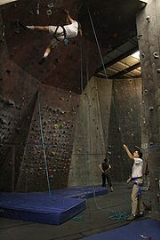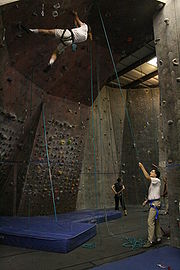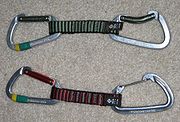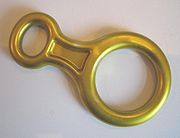
Indoor climbing
Encyclopedia

Rock climbing
Rock climbing also lightly called 'The Gravity Game', is a sport in which participants climb up, down or across natural rock formations or artificial rock walls. The goal is to reach the summit of a formation or the endpoint of a pre-defined route without falling...
performed on artificial structures that attempt to mimic the experience of outdoor rock.
Competetive indoor climbing is also called sport climbing.
The proliferation of indoor climbing gyms has increased the accessibility, and thus the popularity, of the sport of climbing. Since environmental conditions (ranging from the structural integrity of the climbing surfaces, to equipment wear, to proper use of equipment) can be more controlled in such a setting, indoor climbing is perhaps a safer and more friendly introduction to the sport. Many rock gyms are settings for birthday parties and youth teams.
This sense of security has a downside- a new gym climber may head to the cliffs and find they do not have all of the necessary skills for climbing in a setting without preplaced anchors, and explicit route finding.
The first indoor walls tended to be made primarily of brick
Brick
A brick is a block of ceramic material used in masonry construction, usually laid using various kinds of mortar. It has been regarded as one of the longest lasting and strongest building materials used throughout history.-History:...
leaving little scope for interesting routes, as the steepness of the wall and variety of the hand holds were somewhat limited. More recently, indoor climbing terrain is constructed of plywood over a metal frame, spray-coated with texture to simulate a rock face. The biggest indoor climbing gym in the USA is Stone Summit, located in Atlanta Georgia.
Indoor climbing has also seen an increase in popularity in areas with rainy climate
Climate
Climate encompasses the statistics of temperature, humidity, atmospheric pressure, wind, rainfall, atmospheric particle count and other meteorological elemental measurements in a given region over long periods...
s where climbing outdoors is sometimes difficult. Besides offering an alternative during inclement weather, many working adults find that they can get to the gym after work and still climb even though it is too dark outside. In order to improve in any sport, consistent practice is crucial. With the advent of indoor climbing, weather, seasonal difficulties, and busy schedules are less of an obstacle to consistent improvement, and enjoyment of the sport.
Lead
Lead is the most classic sport climbing discipline. Athletes climb a long difficult route designed and set by the route setterRoute setter
A route setter is a person who designs artificial rock climbing wall routes. Also known as "setters", these professionals combine technical craft with an artistic representation of real rock climbing moves. They do this with modular resin holds or "grips" that mimic real rock features...
, and attempt to reach the top, which in climbing terms is the end of the route.
The climber’s performance equates to the highest hold reached. In the qualifying round competitors climb the route 'flash', meaning there is no isolation and they can watch other competitors climb before their own attempt.In the Semifinals and Finals athletes climb a route they have never seen before. They enter isolation before the round begins, then they go for 'observation', a 6-minute period in which the route setter gives a short explanation about the route, and athletes are allowed to see the route and visualize moves. After that they go back to isolation and come back for their attempt one by one.
In lead, climbers are belayed from below, and are required to clip quick-draws along the route.
The route must be climbed within a certain time limit, usually 6 minutes, but can be extended to 7 or 8 minutes according to the route setter's opinion.
26 athletes qualify for the Semifinal, 8 proceed to the Final.
If athletes are joint-equal there will be a Superfinal.
Bouldering
The bouldering competition consists of climbing without belay ropes on short walls, max 4.5 m high. Falls are stopped by specifically engineered mattresses. This discipline is marked by high difficulty concentrated into a short route, the limited competition time and the close proximity to the spectators. It differs especially from Lead in one respect,that the climber can attempt a route more than once.The competitor's score is determined by the overall number of boulders sent by the him/her and the number of attempts needed. If athletes do not reach the finishing hold they may be awarded a bonus point for having reached a particular hold,the Bonus hold, which is marked by the route setter
Route setter
A route setter is a person who designs artificial rock climbing wall routes. Also known as "setters", these professionals combine technical craft with an artistic representation of real rock climbing moves. They do this with modular resin holds or "grips" that mimic real rock features...
.
In bouldering 20 athletes qualify for the Semifinal, and 6 proceed to the Final.
Speed
Speed is the only factor that counts in the Speed Climbing event. Competitors climb a slightly overhanging IFSC certified vertical piste with belaying from the top.Since 2007 the IFSC has created a standard wall for the world record.The climbing time is determined by mechanical-electric timing (the competitor strikes a switch at the top of the route) but manual timing is also possible. When mechanical-electric timing is used, the climbing time shall be measured with an accuracy of 0.01 second. As of October 2011,Qixin Zhong of China holds the men's 15 meter speed world record, 6.26 seconds. He Cuilian, also from China, holds the women's record of 9.04.
Team Speed
The new Team Speed discipline was introduced as a medal showcase for the 2011 World Championship.It is a relay competition with teams of three. The teams must be mixed sexes, men and women. The race is held on the world record wall split into four lanes, two for each team. The first athlete races to hit the button at the top of the wall, at which point the second athlete climbs the second leg to release the third and final athlete whose final button marks the total time.
Duel
Duel is not yet an official medal competition,but it is part of Rock Master competition finals. Duel is a combination of lead and speed.The two athletes compete on two identical, parallel routes, and they are belayed from below. Whoever gets to the top first, wins.
Climbing Wall Construction method
The most common construction method involves screwing resin hand holds on to wooden boards. The boards can be of varying height & steepness (from completely horizontal 'roofRoof
A roof is the covering on the uppermost part of a building. A roof protects the building and its contents from the effects of weather. Structures that require roofs range from a letter box to a cathedral or stadium, dwellings being the most numerous....
s' to not even vertical 'slab
Slab
-Physical materials:* Slab , a length of metal* Concrete slab, a flat plate used in construction* A piece of stone or concrete used to pave sidewalks or road surfaces* Slab : That portion of a tectonic plate that is subducting...
s') and have a large variety of holds (such as very small 'crimps,' slanted-surfaced 'slopers,' and 'jugs,' which are often large and easy to hold) attached. This variety, coupled with the ability for the climbs to be changed by attaching the holds onto the wall differently, has resulted in indoor climbing becoming a very successful sport.
Shoes
Climbing shoes enhance climbing ability. Improvements in shoe design alone have allowed climbers to climb many routes previously unclimbable. The modern climbing shoe has a stiff, smooth rubber sole that protects the foot from sharp, rough rock, and provides more friction than a bare foot. Most prominent climbing shoe producers are La Sportiva, Five Ten, Mad rock, and Mammut.Rope
A modern climbing rope, a key piece of safety equipment, is of kernmantle construction, consisting of continuous braided nylon fibers, the kern, surrounded by a continuous braided nylon outer sheath, the mantle. Such construction is superior to the more traditional laid rope (three large strands twisted together) because the outer sheath protects the inner core, where most of the strength lies, from the elements.Climbing rope is dynamic: able to stretch a bit under tension. This is because the rope must stop falling climbers. If the rope did not stretch, a falling climber would be jerked suddenly as the rope stoped him/her. Instead, the rope slows his/her fall more gently.
Carabiners

Carabiner
A carabiner or karabiner is a metal loop with a sprung or screwed gate that is used to quickly and reversibly connect components in safety-critical systems. The word comes from "Karabinerhaken", meaning "hook for a carbine" in German.-Use:...
, used constantly in climbing, are rings of solid aluminum with a spring-loaded gate that allows them to be opened. Normally, the spring holds the gate closed, but the gate can be opened to admit a rope. Usually two kinds of carabiners are used in indoor climbing. D-shaped straight gate carabiners for quick-draws in the lead discipline,and screw-locker carabiners for belaying in lead and speed.
Harnesses
To attach him/herself to a rope, a climber uses a sewn harness. A typical one has a wide nylon belt for the waist and a pair of leg loops for the thighs. When a climber is supported by such a harness, most of her/his weight is placed on her/his legs, rather than her/his waist, making it fairly comfortable to hang in.Harnesses for women are slightly different in shape, in order to make them more comfortable.
Belay Devices


.jpg)
Carabiner
A carabiner or karabiner is a metal loop with a sprung or screwed gate that is used to quickly and reversibly connect components in safety-critical systems. The word comes from "Karabinerhaken", meaning "hook for a carbine" in German.-Use:...
. There are many belay devices, such as a figure eight, which is used in competitions, Reverso and Grigri.
Chalk bag
These are hand-sized fabric bags for holding climbers' chalk. Chalk bags are usually cylinder- or pouch-shaped and have openings that are controlled by drawstrings. The inner fabric is usually fleece, which traps chalk powder. The outer fabric may be brightly colored or patterned. Chalk bags are usually attached to the back of a waist belt for easy access by either hand during a climb.The powdered chalk may be loose in the bag, or, increasingly, a chalk sock, or chalk ball, which is filled with the chalk and then placed into the chalk bag. Chalk socks are pouches made from a porous sock-like material that allows some chalk dust to be excreted when squeezed or rubbed. They allow just enough chalk to be released while keeping the remainder contained.This prevents the unnecessary scattering of dust that loose chalk often causes.
Speed climbers usually use "liquid chalk" instead, because naturally they can't use chalk bags. Some lead and boulder climbers also choose to begin climbing with liquid chalk, because it lasts longer.
Olympics Participation
In 2011, IOC announced that sport climbing is one of the 8 sports shortlisted for the Olympics 2020.(although IOC had already officially recognized sport climbing).The sports in the shortlist will be considered for inclusion in the 2020 Summer Olympiad. The IOC will take the final decision on the sport to be admitted in 2013, at the 125th IOC session in Buenos Aires.External links
- Climbing Wall Association - a 501(c)(06), non-profit, industry trade association

